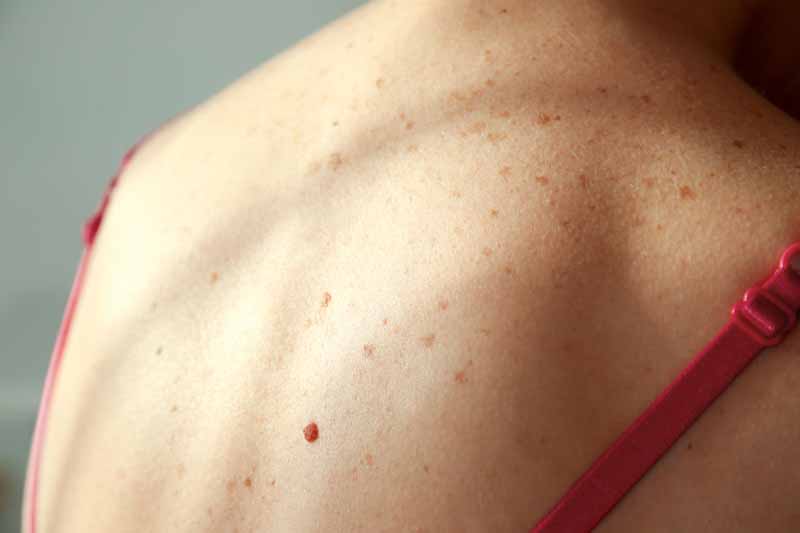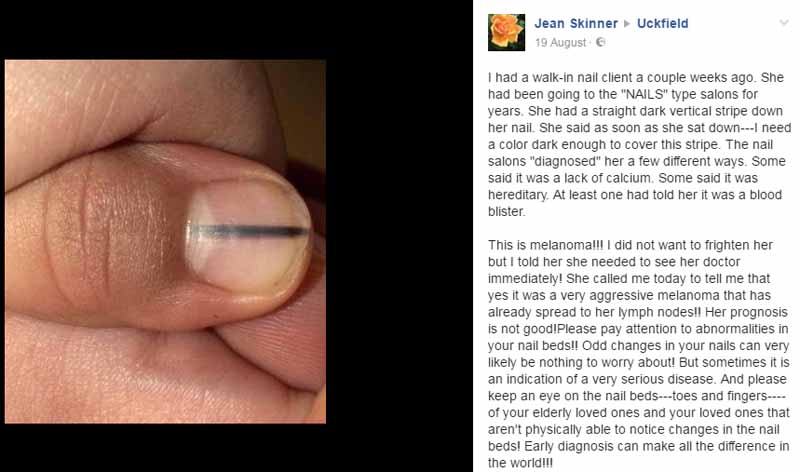
Spa service providers play a crucial role in skin cancer detection. These are the signs that your spa client may have skin cancer.
A Facebook post has been making the rounds lately about a nail salon employee spotting melanoma under a client’s thumbnail. The story is that the nail tech spotted the stripe and recognized it as melanoma, even though other service providers had told the client that she had a calcium deficiency or a blood blister.
The cancer had allegedly spread to her lymph nodes
The post alleges that a doctor later confirmed the salon employee’s diagnosis and found that the cancer had spread to the woman’s lymph nodes, and that her prognosis was “not good.”
According to the Independent, the post was originally published in 2017 by a UK beauty technician named Jean Skinner (that version is no longer available online but there are screenshots). It has since been shared on Facebook, word for word, by others. The post reads:
I had a walk-in nail client a couple weeks ago. She had been going to the “NAILS” type salons for years. She had a straight dark vertical stripe down her nail. She said as soon as she sat down—I need a color dark enough to cover this stripe. The nail salons “diagnosed” her a few different ways. Some said it was a lack of calcium. Some said it was hereditary. At least one had told her it was a blood blister.
This is melanoma!!! I did not want to frighten her but I told her she needed to see her doctor immediately! She called me today to tell me that yes it was a very aggressive melanoma that has already spread to her lymph nodes!! Her prognosis is not good! Please pay attention to abnormalities in your nail beds!! Odd changes in your nails can very likely be nothing to worry about! But sometimes it is an indication of a very serious disease. And please keep an eye on the nail beds—toes and fingers—-of your elderly loved ones and your loved ones that aren’t physically able to notice changes in the nail beds! Early diagnosis can make all the difference in the world!!!

Knowing the signs of skin cancer is key to saving lives
This is a good reminder to spa service providers that being informed about potential signs of skin cancer, and speaking up when you see them, can make a big different in a client’s life.
For more information on these indicators, and on whether a black line down the nail really is an indication of melanoma, we reached out to San Diego dermatologist and spokesperson for the Skin Cancer Foundation, Susan Boiko.
Yes, a black line under the nail could be melanoma
Dr. Boiko confirmed, when we showed her the picture from the post, that a black line under the nail can, indeed, be melanoma.
She said, “There are lots of reasons why you could have a dark stripe under your nail, some of which are nothing to worry about. But this is clearly abnormal. It stands out and is different.”
“Different” is the first indicator that something might be wrong
“Different,” she said, is one of the first things to take note of. “Different doesn’t always mean bad, it just means different. You can see pictures of common skin cancers on the Skin Cancer Foundation website, but in my long career as a dermatologist I have seen cancers that don’t look like those typical pictures. So, the most important thing is something that is different.”
Other concerning signs as listed by Dr. Boiko and on the Skin Cancer Foundation website, can be as follows:
Bleeding: Dr. Boiko said, “One thing that is really a waving red flag is something that is bleeding. If you see something that is bleeding that is a sign that someone should see their doctor.”
Asymmetry: An asymmetrical mark can be a cause for concern. Dr. Boiko said, “If you cut the spot out and folded it over, one half would not match the other.
Irregular border: Is it very clear where the border begins and ends? And is the border smooth? Skin cancers tend to have unclear borders, as well as scalloped or notched borders, while regular moles have smooth borders.
Unusual color: “It could be black, brown, pink, red, white, it could even look like a scar,” said Dr. Boiko. But varied shades of black or brown may be first signs of melanoma, and as the cancers progresses, red, white, or blue may appear. Benign moles are usually one or two shades of brown.
Larger diameter: If you see something bigger than a pencil eraser, that can be an alarming sign. It isn’t always, but it can be. “I have seen skin cancers that are smaller than a pencil eraser. But if something is getting bigger, you want to get it checked,” said Dr. Boiko.
Darkness: Melanomas are often darker in color compared to normal moles. As noted above, however, they can also be lighter in color or pink. And rare, amelanotic melanomas are colorless.
Something that wasn’t there before or is evolving or changing: If you see a client regularly, you might notice a mark that is changing over time, or something you don’t remember being there before. This is important to point out. Normal moles and birthmarks don’t tend to change.
Spa service providers play a crucial role in skin cancer detection
Dr. Boiko said that spa service providers and hair stylists can play a crucial role in detection of skin cancers. She explained, “When a client is coming in for a spa treatment, they may not even be aware that these things exist. Because there are many skin cancers that have no symptoms and don’t bleed, especially melanoma skin cancers. They’re flat, so you can’t feel anything. So, the ability to see that something is different and to bring it to the attention of the client is the most important skill.”
Skin cancers often appear in places people can’t see on themselves
Also, skin cancers also often occur in places people can’t see on themselves. The most common place for men to develop melanoma skin cancer is on the back and the most common place for women is on the back of the calf.
That being said, it isn’t the place of the service provider to make a diagnosis.
Dr. Boiko says, “It’s not the job of the person working in the spa to say something looks like cancer, or even looks healthy or unhealthy, but it is the job to say that something looks different and to ask them to see their doctor.”
She also suggests you take a picture, so that the person and the doctor can easily find the spot.
“Don’t take it super close. Take it in a way that we can see where the other landmarks on the body are. That is very helpful when the person comes to my office and then I can easily locate where the problem is.”
Recognizing the signs and speaking up can save a life, and both the client and the doctor will be grateful to you.
Dr. Boiko said, “I always tell someone who has been sent to me because of a hairdresser or massage therapist that they should reward that person and let them know how appreciative the doctor is that they were able to find that spot.”
Spa Executive magazine is published by Book4Time, the world’s most innovative spa, salon, wellness, and activity management software. Learn more at Book4Time.com.



